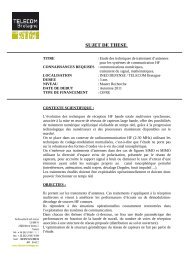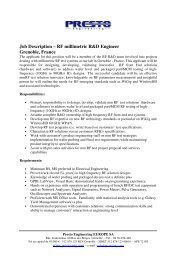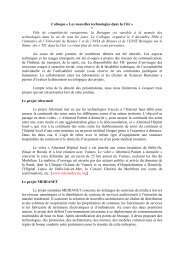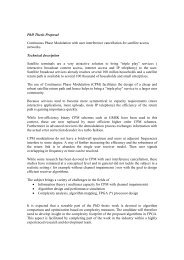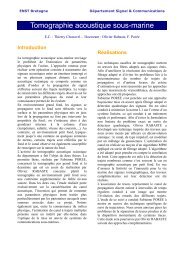Département Réseau, Sécurité et Multimédia Rapport d'Activités 2008
Département Réseau, Sécurité et Multimédia Rapport d'Activités 2008
Département Réseau, Sécurité et Multimédia Rapport d'Activités 2008
Create successful ePaper yourself
Turn your PDF publications into a flip-book with our unique Google optimized e-Paper software.
Multicast for high speed wireless n<strong>et</strong>worksResearch Staff : Xavier Lagrange – Ph.D. Student : Neila El HéniKeywords : multicast, scheduling, QoS, resource management, HSDPAApplications : Wireless Intern<strong>et</strong> AccessPartners & Funding : TELECOM Br<strong>et</strong>agneIntroductionMulticast services have paid a lot of attentionfor a few years. MBMS (MultimediaBroadcast/Multicast Service) is currentlyspecified in the 3GPP recommendation.However, the focus is on the access and thecore n<strong>et</strong>work rather then on the radiointerface.In parallel, high speed data transmission hasbeen specified on existing radio interfaces: forinstance HSDPA (High Speed Data Pack<strong>et</strong>Access) is defined for UMTS (Universal MobileTelecommunications Systems). The mainprinciple is to split data in short blocks and touse statistical time-based multiplexing: at eachTTI (Time Transmission Interval) a schedulerdecides which user to serve based on thestates of the different queues and on theinstantaneous quality of the channel of eachuser. Furthermore HSDPA includes linkadaptation: the level of redundancy is reducedif the channel quality is good and hence theuser-data block size is higher.The standard way to manage multicastservices on the radio interface is to duplicat<strong>et</strong>ransmissions to the different User Equipments(UEs). We call this approach "multiple unicast".This may however considerably waste radioresource if there are several users registeredto the same service in the same cell as onlyone user is served at each TTI. In this work,we then study how real multicast may bedefined on the radio interface and what itsperformance is.RealizationIn order to avoid pack<strong>et</strong>s loss, a multicastscheduler must consider the worst case; i.e.adapt the block size (hence the level ofredundancy) to the mobile of the multicastgroup that has the lowest SNR. On theopposite, in multiple unicast the scheduler maychoose to serve the user that has the best SNRat each TTI. Hence, the gain of using such aconservative multicast scheduling standardsystems is not easily predictable compared toan optimal multiple unicast.We compared the performance of multicastand multiple unicast for several UEs that hav<strong>et</strong>he same mean SNR but random instantaneousvalues due to different fading conditions. Wedefine the multicast gain as the ratio b<strong>et</strong>weenthe maximum user rate at the base station formulticast and the equivalent rate for multipleunicast. It can be seen on figure 1 that belowa mean SNR of approximately 5 dB multipleunicast must be preferred. Above this value,multicast is b<strong>et</strong>ter. The gain is higher if alarger number of user is considered.Figure 1. Multicast gain as a function of themean SNRThe performance was studied [2] for a genericsystem by using the Shannon formula butresults was confirmed by a simulation on theEurane simulator [1].Future WorkThe study will be extended to a more generalcase with different mean SNR. Differentscheduling policies will be studied formulticast. An interesting extension is also toconsider how macro-diversity can improve theperformance of multicast.References[1] Eurane website. http://www.tiwmc.nl/eurane/[2] N. El Héni, X. Lagrange, "Multicast vsmultiple unicast scheduling in high-speedcellular n<strong>et</strong>works," VTC<strong>2008</strong>-Spring,Singapore, May 08Pracom’s Annual Report <strong>2008</strong> 21




